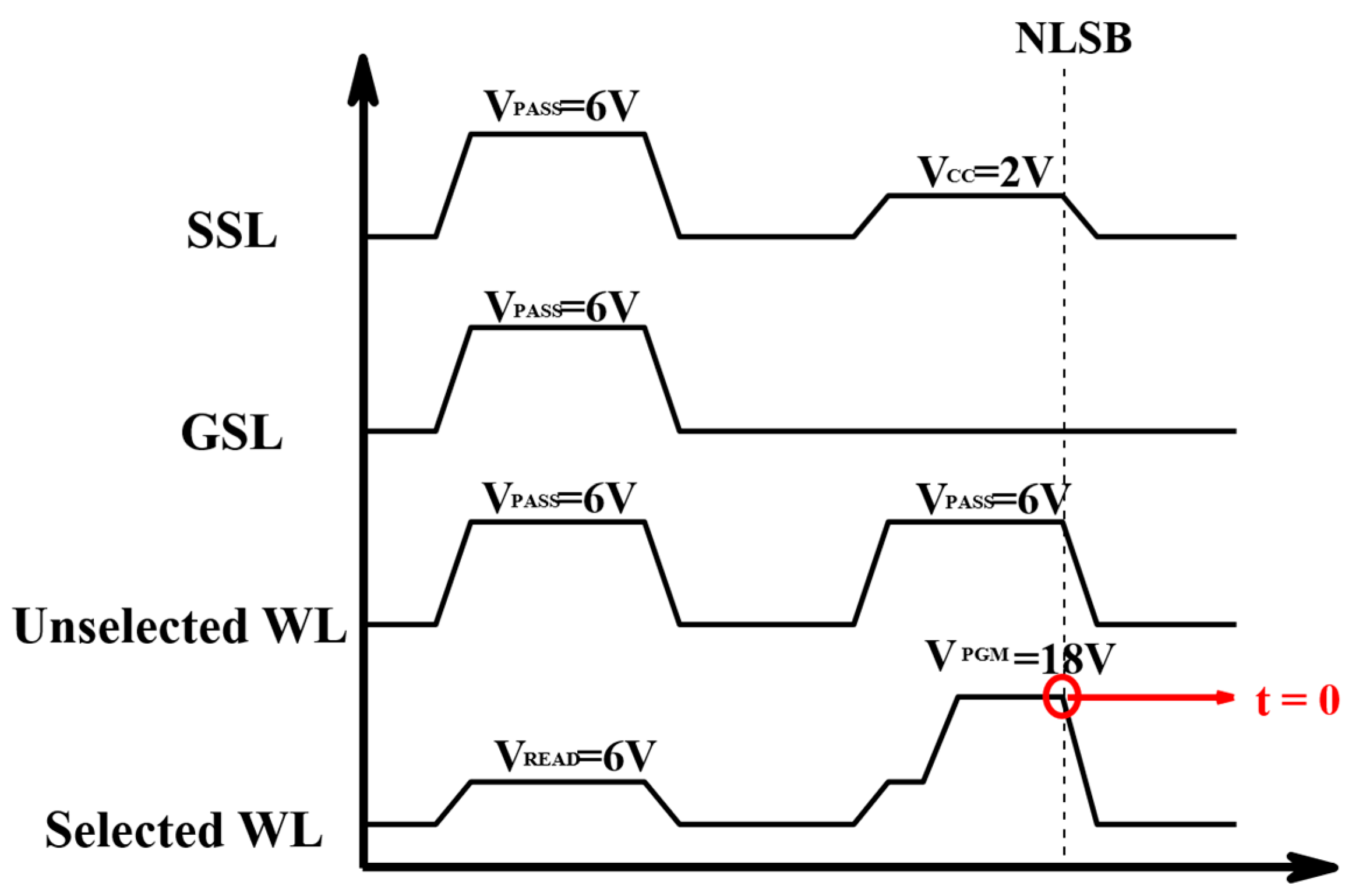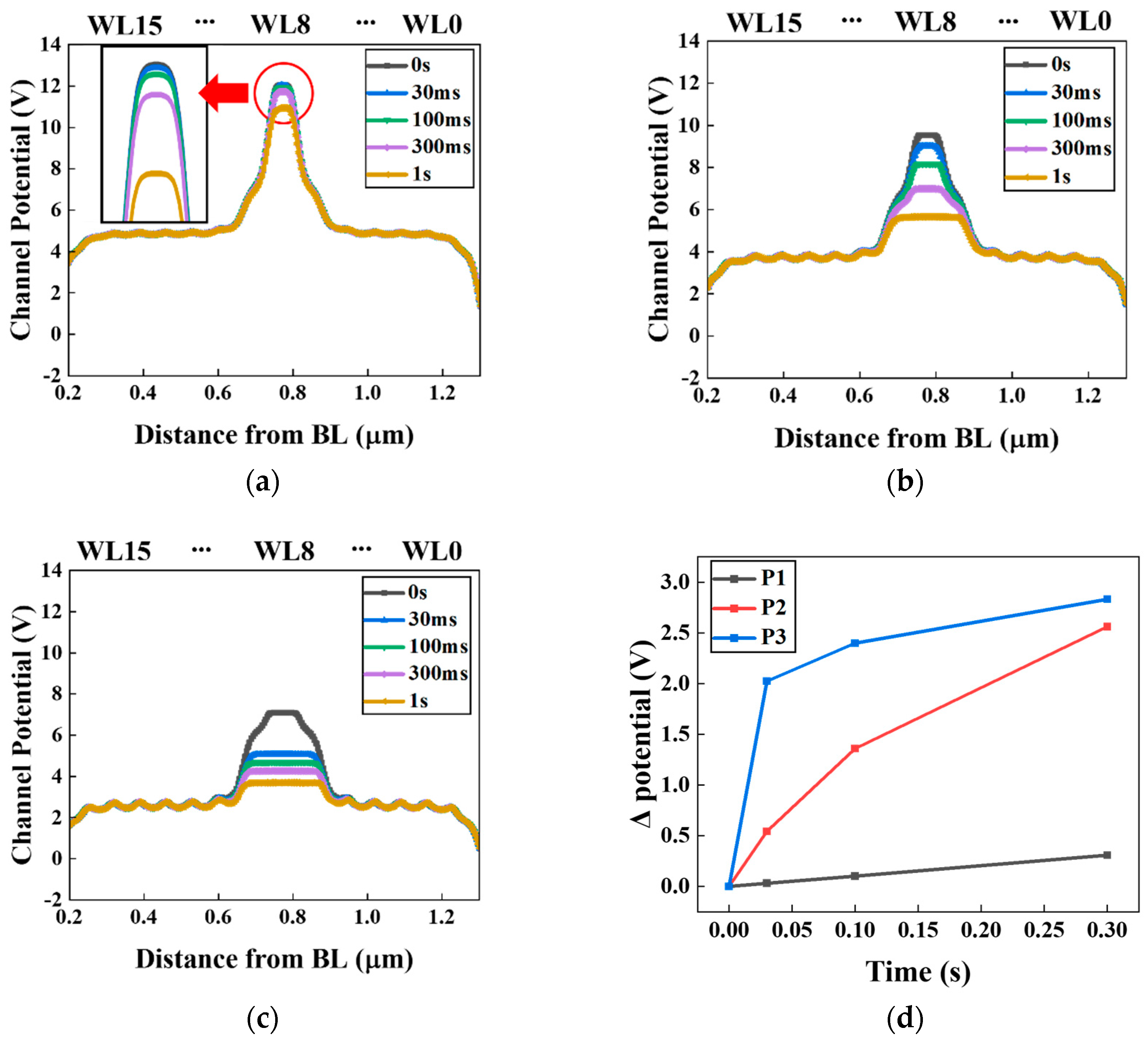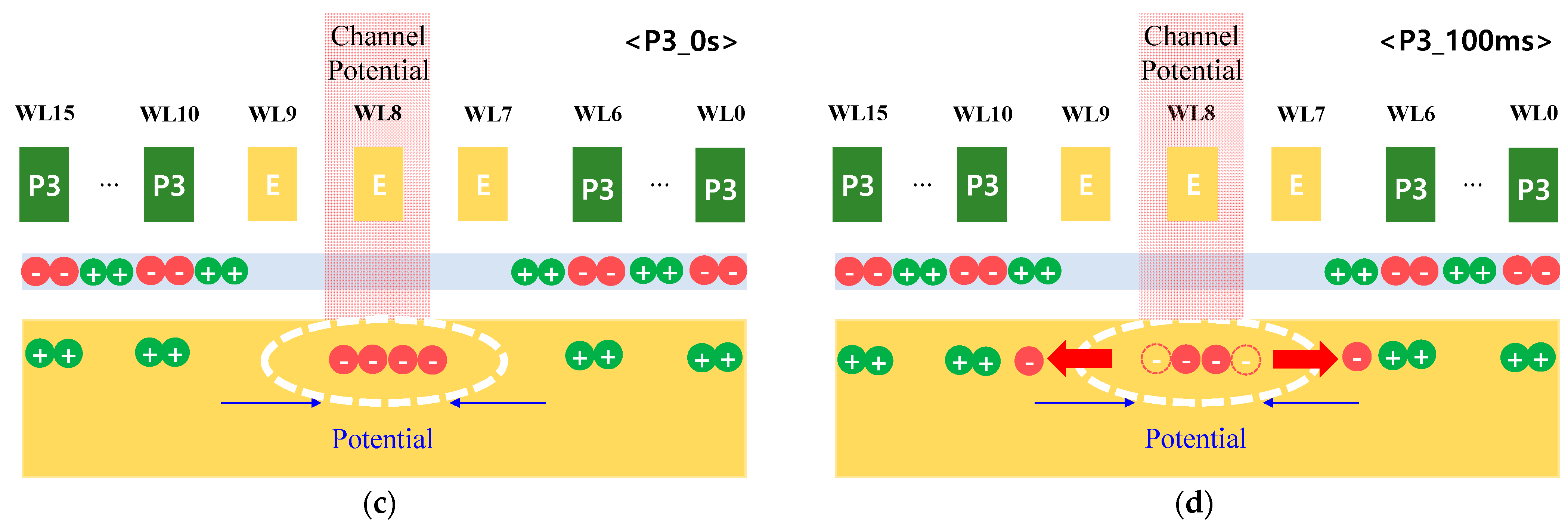Inhibited Channel Potential of 3D NAND Flash Memory String According to Transient Time
Abstract
1. Introduction
2. Structure of the Proposed 3D NAND Flash Memory
3. Results
4. Conclusions
Author Contributions
Funding
Institutional Review Board Statement
Informed Consent Statement
Data Availability Statement
Conflicts of Interest
References
- Kim, Y.; Yun, J.G.; Park, S.H.; Kim, W.; Seo, J.Y.; Kang, M.; Ryoo, K.C.; Oh, J.H.; Lee, J.H.; Shin, H.; et al. Threedimensional NAND flash architecture design based on single-crystalline stacked array. IEEE Trans. Electron Devices 2011, 59, 35–45. [Google Scholar] [CrossRef]
- Jeong, W.; Im, J.W.; Kim, D.H.; Nam, S.W.; Shim, D.K.; Choi, M.H.; Yoon, H.J.; Kim, D.H.; Kim, Y.S.; Park, H.W.; et al. A 128 Gb 3b/cell V-NAND Flash Memory With 1 Gb/s I/O Rate. IEEE J. Solid-State Circuits 2016, 51, 204–212. [Google Scholar]
- Jang, J.; Kim, H.S.; Cho, W.; Cho, H.; Kim, J.; Shim, S.I.; Jeong, J.H.; Son, B.K.; Kim, D.W.; Shim, J.J.; et al. Vertical cell array using TCAT(Terabit Cell Array Transistor) technology for ultra-high density NAND flash memory. In Proceedings of the 2009 Symposium on VLSI Technology, Kyoto, Japan, 15–17 June 2009; IEEE: Piscataway, NJ, USA, 2009; pp. 192–193. [Google Scholar]
- Kim, Y.; Seo, J.Y.; Lee, S.-H.; Park, B.-G. A new programming method to alleviate the program speed variation in three-dimensional stacked array NAND flash memory. J. Semicond. Technol. Sci. 2014, 14, 566–571. [Google Scholar] [CrossRef]
- Jeong, M.-K.; Joe, S.-M.; Jo, B.-S.; Kang, H.-J.; Bae, J.-H.; Han, K.-R.; Choi, E.; Cho, G.; Park, S.-K.; Park, B.-G.; et al. Characterization of traps in 3-D stacked NAND flash memory devices with tubetype poly-Si channel structure. In Proceedings of the 2012 International Electron Devices Meeting, San Francisco, CA, USA, 10–13 December 2012; pp. 9.3.1–9.3.4. [Google Scholar]
- Park, Y.; Lee, J.; Cho, S.S.; Jin, G.; Jung, E. Scaling and reliability of NAND flash devices. In Proceedings of the 2014 IEEE International Reliability Physics Symposium, Waikoloa, HI, USA, 1–5 June 2014; pp. 2E.1.1–2E.1.4. [Google Scholar] [CrossRef]
- Park, M.; Kim, K.; Park, J.-H.; Choi, J.-H. Direct field effect of neighboring cell transistor on cell-to-cell interference of NAND flash cell arrays. IEEE Electron Device Lett. 2008, 30, 174–177. [Google Scholar] [CrossRef]
- Park, K.T.; Nam, S.; Kim, D.; Kwak, P.; Lee, D.; Choi, Y.H.; Choi, M.H.; Kwak, D.H.; Kim, D.H.; Kim, M.S.; et al. Three-dimensional 128 Gb MLC vertical NAND flash memory with 24-WL stacked layers and 50 MB/s high-speed programming. IEEE J. Solid-State Circuits 2014, 50, 204–213. [Google Scholar] [CrossRef]
- Ham, I.; Jeong, Y.; Baik, S.J.; Kang, M. Ferroelectric polarization aided low voltage operation of 3D NAND flash memories. Electronics 2020, 10, 38. [Google Scholar] [CrossRef]
- Kim, Y.; Kang, M. Down-coupling phenomenon of floating channel in 3D NAND flash memory. IEEE Electron Device Lett. 2016, 37, 1566–1569. [Google Scholar] [CrossRef]
- Atlas User’s Manual, Silvaco Version. 5.19.20. Available online: http://www.silvaco.com/products/tcad/device_simulation/atlas/atlas.html (accessed on 3 February 2020).
- Kim, H.; Kang, M. Analysis of DCP and NLSB Recovery Time in 3D NAND Flash Memory. Knut Dcollection. February 2023. Available online: http://www.dcollection.net/handler/chains/200000667859 (accessed on 3 February 2023).
- Jung, S.G.; Lee, K.W.; Kim, K.S.; Shin, S.W.; Lee, S.S.; Om, J.C.; Bae, G.H.; Lee, J.H. Modeling of VTH shift in NAND Flash memory cell device considering crosstalk and short channel effect. IEEE Trans. Electron Devices 2008, 55, 1020–1026. [Google Scholar] [CrossRef]
- Choi, B.Y.; Sung, S.K.; Park, S.J.; Kim, T.H.; Kim, M.; Lee, S.H.; Kim, M.J.; Kwon, S.H.; Jang, D.H.; Hyun, K.S.; et al. New source/drain hot carrier injection disturbance of NAND Flash devices. J. Korean Phys. Soc. 2010, 56, 142–146. [Google Scholar] [CrossRef]
- Lee, J.-D.; Lee, C.-K.; Lee, M.-W.; Kim, H.-S.; Park, K.-C.; Lee, W.-S. A new programming disturbance phenomenon in NAND Flash memory by source/drain hot-electron generated by GIDL current. In Proceedings of the 2006 21st IEEE Non-Volatile Semiconductor Memory Workshop, Monterey, CA, USA, 12–16 February 2006; pp. 31–33. [Google Scholar]
- Larcher, L.; Padovani, A.; Pavan, P.; Fantini, P.; Calderoni, A.; Mauri, A.; Benvenuti, A. Modeling NAND Flash memories for IC design. IEEE Electron. Device Lett. 2008, 29, 1152–1154. [Google Scholar] [CrossRef]
- Lee, D.; Chang, I.J.; Yoon, S.-Y.; Jang, J.; Jang, D.-S.; Hahn, W.-G.; Park, J.-Y.; Kim, D.-G.; Yoon, C.; Lim, B.-S.; et al. A 64Gb 533Mb/s DDR interface MLC NAND Flash in sub-20nm technology. In Proceedings of the 2012 IEEE International Solid-State Circuits Conference, San Francisco, CA, USA, 19–23 February 2012; pp. 430–432. [Google Scholar]
- Kang, M.; Kim, Y. Natural local self-boosting effect in 3D NAND flash memory. IEEE Electron. Device Lett. 2017, 38, 1236–1239. [Google Scholar] [CrossRef]






| Quantity | Value |
|---|---|
| Gate length (WL) | 40 nm |
| Gate length (SSL, GSL) | 150 nm |
| Gate spacing | 30 nm |
| Gate dielectrics (O/N/O) | 4/8/8 nm |
| Channel hole diameter | 80 nm |
| Poly-Si channel thickness | 10 nm |
| Selected WL | WL8 |
| VCC | 2 V |
| Doping (Arsenic/Boron) | 1 × 1020/cm3/1 × 1018/cm3 |
Disclaimer/Publisher’s Note: The statements, opinions and data contained in all publications are solely those of the individual author(s) and contributor(s) and not of MDPI and/or the editor(s). MDPI and/or the editor(s) disclaim responsibility for any injury to people or property resulting from any ideas, methods, instructions or products referred to in the content. |
© 2023 by the authors. Licensee MDPI, Basel, Switzerland. This article is an open access article distributed under the terms and conditions of the Creative Commons Attribution (CC BY) license (https://creativecommons.org/licenses/by/4.0/).
Share and Cite
Cho, T.; Kim, H.; Kang, M. Inhibited Channel Potential of 3D NAND Flash Memory String According to Transient Time. Appl. Sci. 2023, 13, 2909. https://doi.org/10.3390/app13052909
Cho T, Kim H, Kang M. Inhibited Channel Potential of 3D NAND Flash Memory String According to Transient Time. Applied Sciences. 2023; 13(5):2909. https://doi.org/10.3390/app13052909
Chicago/Turabian StyleCho, Taeyoung, Hyunju Kim, and Myounggon Kang. 2023. "Inhibited Channel Potential of 3D NAND Flash Memory String According to Transient Time" Applied Sciences 13, no. 5: 2909. https://doi.org/10.3390/app13052909
APA StyleCho, T., Kim, H., & Kang, M. (2023). Inhibited Channel Potential of 3D NAND Flash Memory String According to Transient Time. Applied Sciences, 13(5), 2909. https://doi.org/10.3390/app13052909







